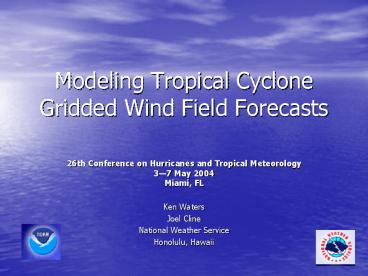Modeling Tropical Cyclone Gridded Wind Field Forecasts PowerPoint PPT Presentation
1 / 16
Title: Modeling Tropical Cyclone Gridded Wind Field Forecasts
1
Modeling Tropical Cyclone Gridded Wind Field
Forecasts
- 26th Conference on Hurricanes and Tropical
Meteorology37 May 2004Miami, FL - Ken Waters
- Joel Cline
- National Weather Service
- Honolulu, Hawaii
2
Modeling Tropical Cyclone Gridded Wind Field
Forecasts
- Background
- Process/Algorithm
- Issues
- Results
- Future Plans
3
Background Purpose
- The goal
- An hourly forecast estimate of surface wind
speeds and direction for 31 island points in the
West Pacific - Needed for
- Terminal Aviation Forecasts (TAFs) for 24-hour
period - Hourly wind forecast needed to help determine
start/stop times for Tropical Storm and Typhoon
Watches and Warnings - Wind grid information for possible initialization
of digital wind grids (National Digital Forecast
Database)
4
Background Warning Points
5
Background Source Warnings
- Official Tropical Cyclone Warnings are produced
by the DoD Joint Typhoon Warning Center in Pearl
Harbor - Forecast of position and maximum sustained wind
speed for Hours 00, 12, 24, 36, 48, 72, 96, and
120 - Estimated wind radii by quadrant for Hours 00-72
6
Background JTWC forecast
Initial Position Lat/Long
Max Wind
12 Hour Forecast Lat/Long Max Wind
24 Hour Forecast
7
Background JTWC forecast Example Graphic
Showing Wind Radii Information
8
Process/Algorithm Rankine Vortex
- Anthes (1982)
V(r) Velocity at distance r from center of
storm V(R0) Maximum Wind Speed at Radius of
Maximum Wind, R0 x exponential form factor,
typically between 0.5 and 0.7 r0 Radius of
storm influence
9
Process/Algorithm Rankine Vortex
- For winds inside the Radius of Maximum Wind
(RMW), use
10
Process/Algorithm
- Interpolate storm forecast to obtain hourly
positions and maximum wind speed - Apply the wind formula for a regular grid
centered upon the storm at each hourly position
as well as for selected point locations (e.g.,
islands) at each hour based on distance from
storm to the island - Compute simple wind direction orthogonal to line
between the storm and the point
11
Process/Algorithm
- National Digital Forecast Database requires
offices to produce surface wind grids of at least
5 km resolution every 3 hours - Following example shows a method of populating
the wind field based solely on the wind radii
(quadrant) information inside the warning --- not
using Rankine vortex
12
(No Transcript)
13
Issues
- Determination of Radius of Maximum Wind (RMW) ---
not part of forecast but input to the formula - Determination of the exponential shape factor
- How rapidly does wind speed fall off as one moves
away from center? - Variances include spectrum from huge storm down
to midget typhoons - Inherent dangers with using a highly
deterministic approach to describe
difficult-to-predict tropical cyclone movement
and intensity
14
Results Typhoon Sudal Apr 9, 2004Warning 20
SYMMETRIC MODEL PREDICTED WINDS FOR Koror
Ngulu Yap 0 340 25 334 56
59 69 1 339 26 330 59 66 73 2 338
26 325 62 74 77 3 337 27 319 66
84 81 4 336 27 312 69 95 84 5 335
28 304 72 106 84 6 334 28 296 74 118
83 7 333 29 286 76 128 80 8 332 29
277 76 136 76 9 330 30 267 75 144 72 10
329 31 259 73 150 68 11 327 31 251 70
154 64 12 326 32 245 67 158 61 13
324 32 241 63 164 59 14 321 33 238 59
169 56 15 319 33 236 56 173 54 16 316
33 234 53 176 52 17 314 34 232 50 180
50 18 311 34 231 48 182 48
HOURLY POSITION/CLOSEST POINT Lat Lon
Wind Mvmt Dstnc/Dirctn
from
(naut mi) 0 8.8 138.5 110.0 282 8
55 SSE Yap 1 8.8 138.4 110.4
282 8 50 SSE Yap 2
8.9 138.3 110.8 282 8 45 SSE Yap
3 8.9 138.2 111.2 282 8
42 S Yap 4 8.9 138.0 111.7
282 8 40 S Yap 5
8.9 137.9 112.1 282 8 40 SSW Yap
6 8.9 137.8 112.5 282 8
42 SSW Yap 7 9.0 137.7 112.9
282 8 44 SW Yap 8
9.0 137.6 113.3 282 8 48 SW Yap
9 9.0 137.4 113.8 282 8
50 N Ngulu 10 9.1 137.3 114.2
282 8 53 N Ngulu
15
Future Plans
- Asymmetric wind structure (moving storm)
- Environmental blending (e.g., SW monsoon flow)
- Verification (using? QuikSCAT? Recon?)
- Create netCDF grids for possible use in
initializing National Digital Forecast Database
wind grids - Explore methods to estimate exponential factor
and Radius of Maximum Wind
16
Questions?
- Text data files can be found at
- http//www.prh.noaa.gov/hq/regsci/wind
- Graphics planned for this spring/summer
Ken Waters Regional Scientist National Weather
Service, Pacific Region 737 Bishop St., Ste.
2200 Honolulu, HI 808-532-6413, cell
808-271-7204 Ken.waters_at_noaa.gov

